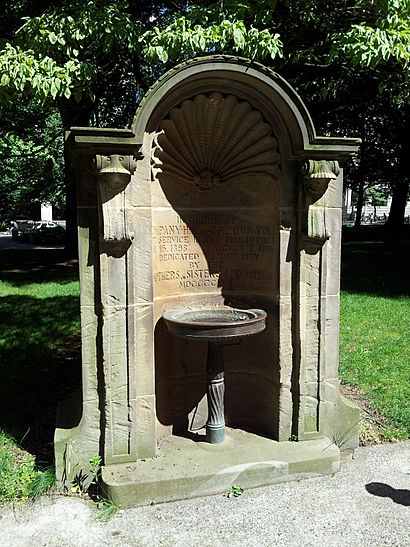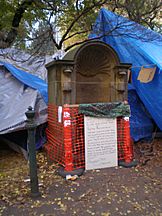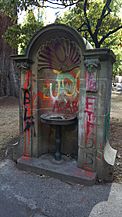Fountain for Company H facts for kids
Quick facts for kids Fountain for Company H |
|
|---|---|
| Second Oregon Company Volunteers | |

The fountain in 2015
|
|
| Artist | John H. Beaver |
| Year | 1914 |
| Type |
|
| Medium |
|
| Dimensions | 2.3 m × 1.6 m × 0.79 m (89 in × 63 in × 31 in) |
| Location | Portland, Oregon, United States |
| 45°30′58″N 122°40′40″W / 45.51617°N 122.67777°W | |
| Owner | City of Portland and Multnomah County Public Art Collection courtesy of the Regional Arts & Culture Council |
The Fountain for Company H is a special fountain and war memorial. It is also known as Second Oregon Company Volunteers. John H. Beaver designed it in 1914. You can find it in Portland, Oregon's Plaza Blocks.
This memorial honors the brave soldiers of Company H. These men were part of the 2nd Oregon Volunteer Infantry Regiment. They lost their lives serving during the Spanish–American War. The memorial is made of limestone and bronze. It was placed in Lownsdale Square in 1914. The City of Portland and Multnomah County own this public artwork. The Regional Arts & Culture Council helps take care of it.
Contents
About the Memorial
This memorial is made from limestone and bronze. It stands on the west side of Lownsdale Square. It faces the Multnomah County Courthouse. You can find it along Southwest 4th Avenue in Downtown Portland.
The memorial has a drinking fountain. This fountain is inside a canopy shaped like a clamshell. It is about 89 inches tall, 63 inches wide, and 31 inches deep. The memorial remembers the soldiers from Company H. They died in the Philippines during the Spanish–American War.
What the Inscription Says
On the west side of the memorial, there is a special message. It tells us who the fountain is for. It also says who gave it to the city.
IN HONOR OF
COMPANY H 2ND OREGON VOLS.
FOR SERVICE IN THE PHILIPPINES
MAY 15, 1898 AUGUST 7, 1899.
DEDICATED TO THE CITY
BY THE
MOTHERS, SISTERS AND WIVES.
MDCCCCXIV
This message means the fountain honors Company H. They served in the Philippines from May 1898 to August 1899. It was given to the city by the mothers, sisters, and wives of the soldiers. The Roman numerals MDCCCCXIV mean 1914.
How the Memorial Was Created
Choosing the Design
A group of women relatives gave this memorial to the city. Most of these women were mothers of the soldiers in Company H. They met often to plan and raise money for the project.
In January 1914, the city announced a competition. Artists could submit designs for a fountain. The city set aside $450 for the fountain. It had to be made of bronze and stone. Artists needed to show detailed drawings of their ideas.
On February 13, the women's group held a meeting. They invited all members and anyone who had joined before. This meeting was to finalize plans for the memorial. John H. Beaver's design was chosen on February 17. A committee led by city commissioner William L. Brewster picked it. Beaver won a $50 prize for his design.
Unveiling the Fountain
The fountain was built by August 30, 1914. It was officially shown to the public on September 2. Henrietta White helped unveil the fountain. She was the great-granddaughter of Diana McDonell, who led the women's group. Henrietta removed a flag that covered the fountain. This flag was given to the company by girls from Portland High School.
Many people spoke at the ceremony. Colonel Charles E. McDonell, a captain in Company H, talked about the women's group. A poem written by June McMillan Ordway was read. The drum corps of the Sons of Spanish–American War Veterans performed. Reverend C. E. Cline gave a prayer. William L. Brewster accepted the memorial for the city. The ceremony ended with everyone singing "America."
Caring for the Memorial
The Smithsonian Institution checked the fountain in 1993. This was part of a program called "Save Outdoor Sculpture!". They wanted to make sure outdoor artworks were in good condition.
During a protest called Occupy Portland in 2011, the fountain was protected. A screen was put around it. A sign asked people to "Please respect this fragile monument." Keith Lachowicz, who manages art collections for the Regional Arts & Culture Council, checked the memorial often. He also checked other nearby monuments.
Some graffiti appeared on the war memorials. But veterans who were part of the protest cleaned it off. Lachowicz said the artworks were not badly damaged. The screen around the fountain had to be replaced once. He noted that the protesters were respectful of the monuments.
The City of Portland and Multnomah County own this memorial. The Regional Arts & Culture Council helps care for it.



